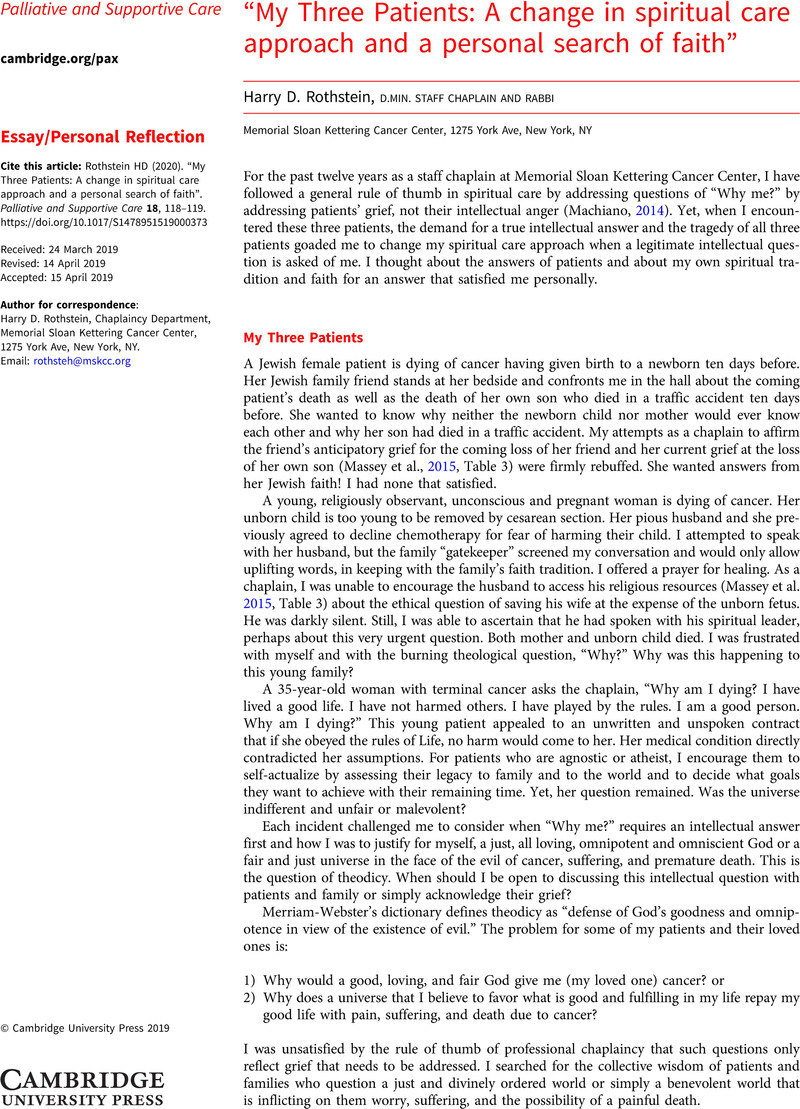No CrossRef data available.
Article contents
“My Three Patients: A change in spiritual care approach and a personal search of faith”
Published online by Cambridge University Press: 13 June 2019
Abstract
An abstract is not available for this content so a preview has been provided. Please use the Get access link above for information on how to access this content.

- Type
- Essay/Personal Reflection
- Information
- Copyright
- Copyright © Cambridge University Press 2019
References
Black, HK and Rubinstein, RL (2004) Themes of suffering in later life. Journal of Gerontology 59b(1), 817–824.Google Scholar
Cook, JA and Wimberley, DW (1983) If I should die before I wake: religious commitment and adjustment to the death of a child. Journal for the Scientific Study of Religion 22(3), 222–238.CrossRefGoogle Scholar
Gall, TL and Cornblat, MW (2002) Breast cancer survivors give voice: a qualitative analysis of spiritual factors in long-term adjustment. Psycho-Oncology 11, 524–535.CrossRefGoogle ScholarPubMed
Henderson, PD, Gore, SV, Davis, BL and Condon, EH (2003) African-American women coping with breast cancer: a qualitative analysis. Oncology Nursing Forum 30(4), 641–647.CrossRefGoogle ScholarPubMed
Machiano, V (2014) Theodicy in the clinical practice of the chaplain. PlainViews 11(1)Google Scholar
Massey, K, Barnes, MJD, Villines, D, Goldstein, JD, Hisey Pierson, AL, Scherer, C, Van der Laan, B and Summerfelt, WT (2015) What do I do? Developing taxonomy of chaplaincy activities and interventions for spiritual care in intensive care unit palliative care. BMC Palliative Care 14, 10.CrossRefGoogle ScholarPubMed
Nelson, CJ, Rosenfeld, B, Breitbart, W and Galietta, M (2002) Spirituality, religion and depression in the terminally ill. Psychosomatics 43(3), 213–220.CrossRefGoogle ScholarPubMed
Swinton, J, Bain, V, Ingram, S and Heys, SD (2011) Moving inwards, moving outwards, moving upwards: the role of spirituality during the early stages of breast cancer. European Journal of Cancer Care 20, 640–652.CrossRefGoogle ScholarPubMed
Taylor, EJ and Outlaw, FH (2002) Use of prayer among persons with cancer. Holistic Nursing Practice 16(3), 46–60.CrossRefGoogle ScholarPubMed
Taylor, EJ, Outlaw, FH, Bernardo, TR and Roy, A (1999) Spiritual conflicts associated with praying about cancer. Psycho Oncology 8, 386–394.3.0.CO;2-C>CrossRefGoogle ScholarPubMed
Tomasetti, C and Vogelstein, B (2015) Variation in cancer risk among tissues can be explained by the number of stem cell divisions. Science 2, 78–80.CrossRefGoogle Scholar
Walton, J and Sullivan, N (2004) Men of prayer: spirituality of men with prostate cancer: a grounded theory study. Journal of Holistic Nursing 22(2), 135–151.CrossRefGoogle ScholarPubMed
Wu, S, Powers, S, Zhu, W and Hannun, YA (2015) Substantial contribution of extrinsic risk factors to cancer development. Nature 529, 43–47.CrossRefGoogle ScholarPubMed




